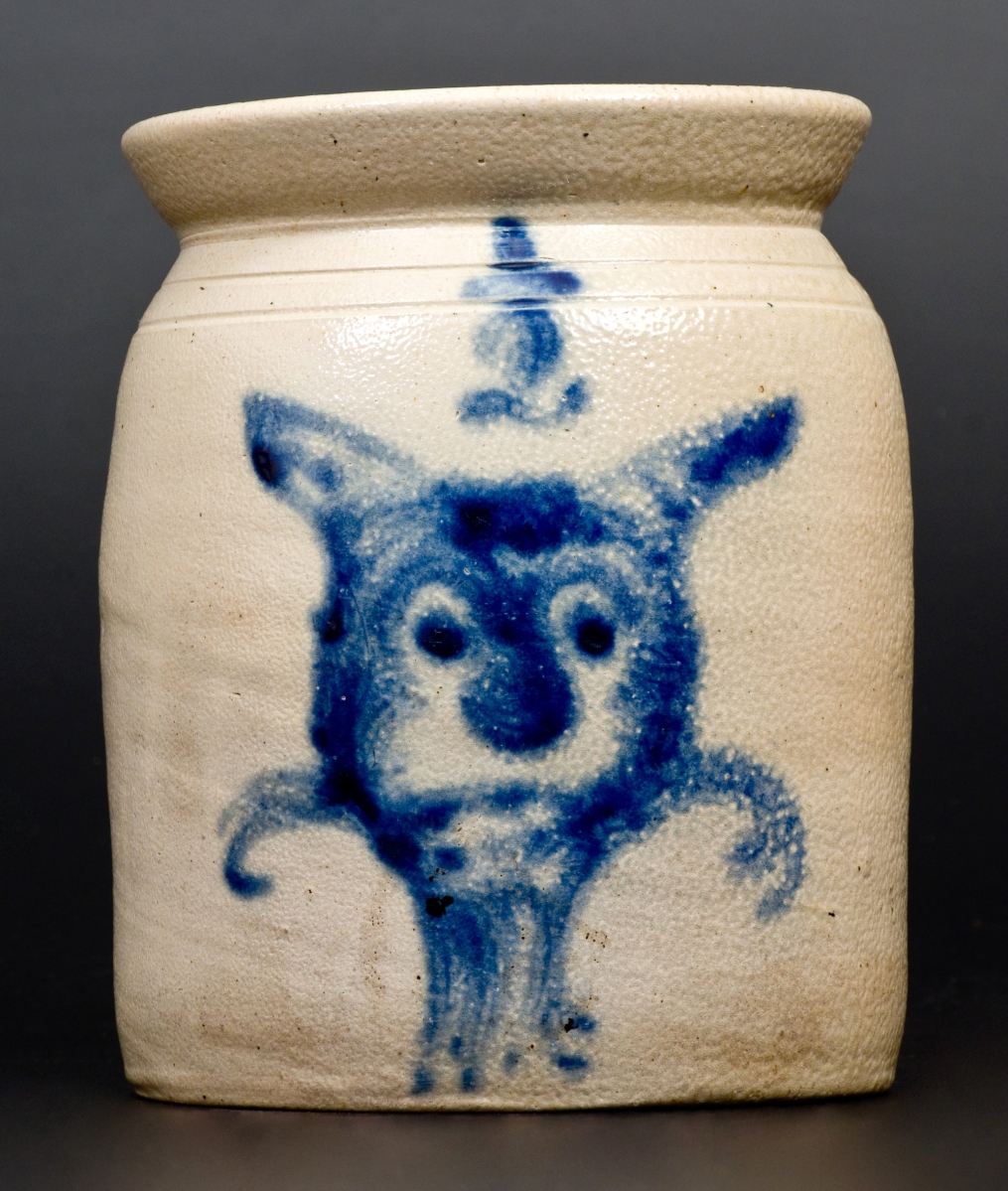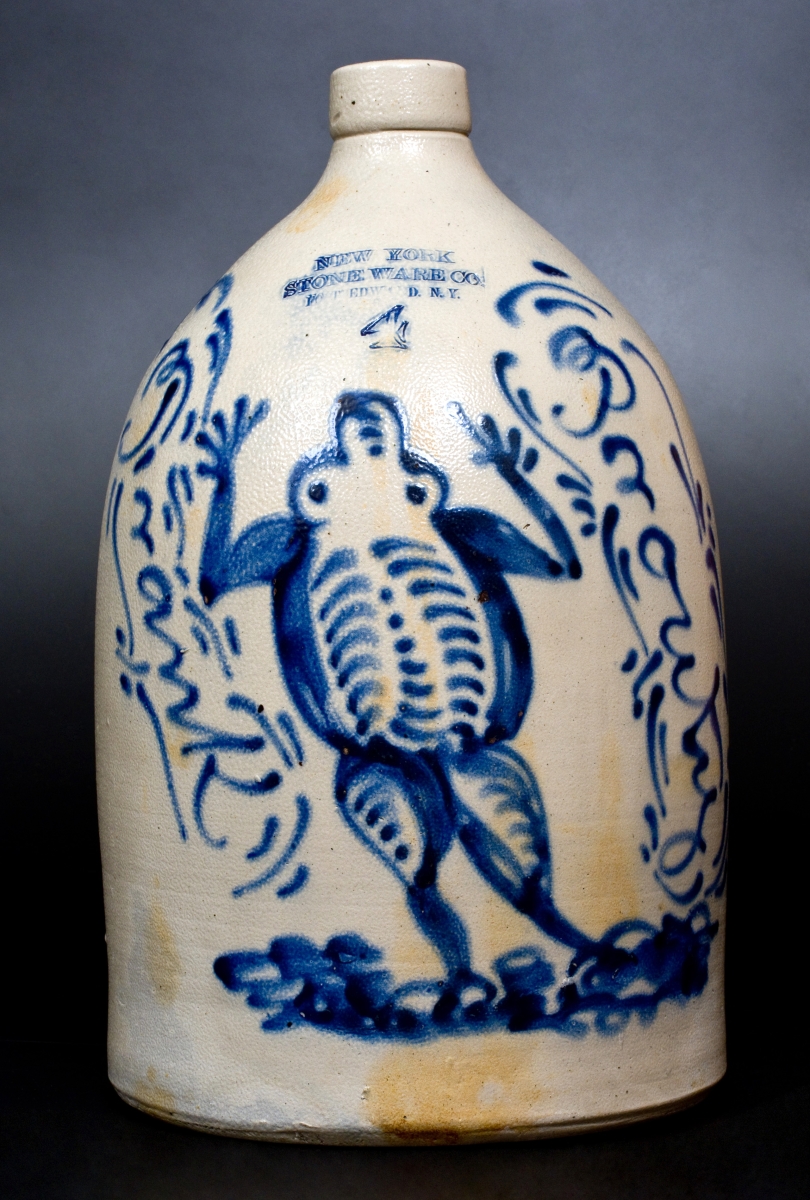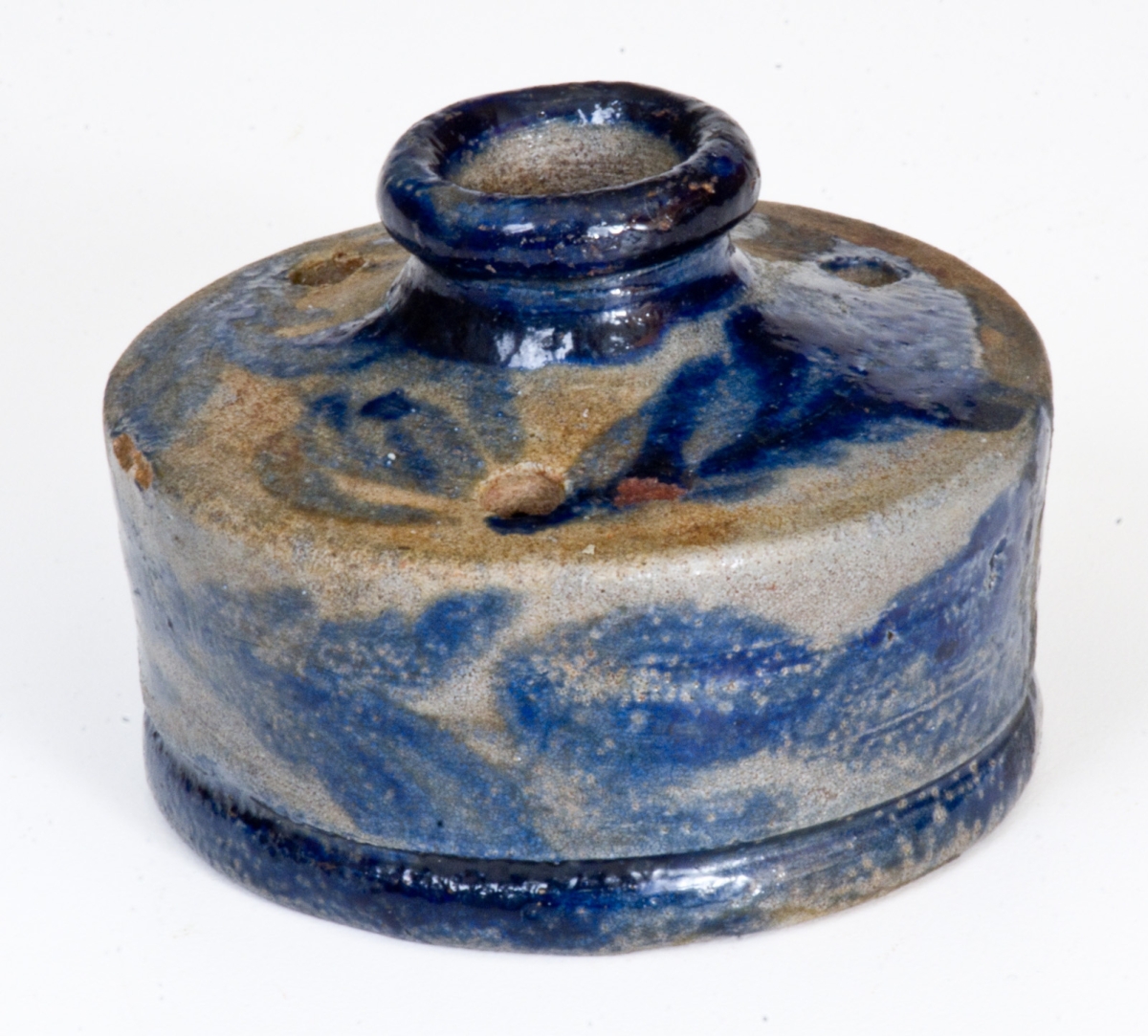Auction Action In Sparks, Md.
SPARKS, MD. — Decorated with the cobalt figure of a leaping frog, a New York 4-gallon jug of circa 1875 jumped to the head of the pack at Crocker Farm’s October 22 sale of American pottery. The auction’s cover lot more than doubled low estimate, going to a collector for $74,750.
According to Crocker Farm owner and founder Tony Zipp, the well-known and much-exhibited piece made $16,000 when it came up at Sotheby’s 1991 auction of the folk art collection of Daphne Farago. The latest transaction represented a handsome return on investment for the consignor of this special piece stamped “New York Stoneware Co. / Fort Edward, N.Y.” Beyond its charming decoration, the jug bears potter George Prouty’s endearing inscription to his son, Frank, who enjoyed a boyish interest in frogs.
“What people look for in stoneware are unique pieces. There are other examples like this one decorated with vertical frogs, but none similarly inscribed,” Zipp explained. Census records from 1870 and 1880 confirm that father and son lived in Fort Edward, N.Y. Frank would have been about 11 when the jug, recognized since the 1970s as an important example of American folk art, was made.
Upstate New York stoneware with figural, as opposed to floral, decoration dominated Crocker Farm’s recent sale. A rooster-decorated 2-gallon jug by William H. Farrar of Geddes, N.Y., exceeded high estimate to bring $19,550. Its appearance in the auctioneer’s handsome catalog elicited the last-minute consignment of a Geddes, N.Y., 4-gallon jug decorated with two roosters. The latter vessel, stamped “C.E. Pharis & Co.” and dated 1864, made $8,050.
Among other New York pieces was a circa 1868 J. Burger Jr of Rochester 6-gallon churn, $8,625, decorated with a seated lion; a Cortland half-gallon jar, $8,825, decorated with a cat’s face and attributed to Madison Woodruff; a circa 1835 Moses Tyler of Albany 2-gallon jug, $4,025, decorated with a horse and rider. A ceramic lion, large at 11¾ inches tall, sold for $10,925.
“If something is really special, it takes off. But overall, prices for Northern stoneware have leveled off. People are realizing that some pieces are not as rare as originally thought,” Zipp noted.
New York City stoneware by Crolius, Commeraw and Remmey is always in demand. This time, a small Thomas Commeraw oyster jar impressed with the name “Brown” and the address “No. 271 Water Street / N. York” sparked bidding, selling for $5,175. It was the same price paid for a Commeraw jar stamped “Daniel / Johnson. / No 24 / Lumber Street / New.York” at Crocker Farm in 2014.
Demand is solid for good Pennsylvania pieces with makers’ marks from the center of the state and is on the uptick for comparable western Pennsylvania wares. A 4-gallon Harrisburg jar with peacock decoration by Cowden & Wilcox made $9,775. A signed John Bell of Waynesboro celadon-glazed quart-sized jug with cobalt tulip decoration went for $2,300.
Enthusiasts usually collect by region, but all seem to love the folky pottery of Morgantown, W.Va., Zipp says. A circa 1860 Morgantown pitcher attributed to David Greenland Thompson crossed the block at $10,925, the same price paid for a Thompson family 3-gallon jar decorated with a coggled town scene and leaf motifs in cobalt.
All graduates of Johns Hopkins University and partners in Crocker Farm, the younger Zipps — Brandt, Luke and Mark — are avid researchers and published scholars. Luke, in fact, spoke at the Museum of Early Southern Decorative Arts (MESDA)’s October 28–30 conference on Southern ceramics. Southern pottery is a hot collecting speciality, thanks in part to scholarly spade work by MESDA, which recently opened its new William C. and Susan S. Mariner Southern Ceramics Gallery, and ongoing efforts by the Chipstone journal .
It was no surprise, then, that some of Crocker Farm’s biggest prices were for Southern pottery. Made around 1830, a double-handled jug signed “Dave” from South Carolina’s Edgefield District fetched $46,000, selling to a Northeastern museum underbid by a New York City collector. The auctioneer believes the piece is the earliest signed work by the craftsman, an enslaved African American, and perhaps his only use of this form, a view supported by “Dave” expert Arthur W. Goldberg, Zipp said.
Collectors are also following MESDA’s lead into the backcountry South. “Kentucky stoneware and redware is very difficult to find,” Zipp remarked, pointing to a rare signed and dated 1795 redware canister by Philip Anthony of Kentucky that sailed past its low estimate to bring $12,650. A John Floyd of Knox County, Tenn., water cooler elicited $7,475. Writhing with applied snakes and insects, a fanciful Texarkana Pottery temperance jar was a hit at $16,100.
Prices reported include the buyer’s premium.
Crocker Farm organizes three major sales a year of antique American stoneware and redware. The firm’s next event is planned for March. Another South Carolina “Dave” piece is promised, so stay tuned.
Crocker Farm is at 15900 York Road. For more information, www.crockerfarm.com or 410-472-2016.
Estimated at only $400/600, this circa 1840 redware bowl from the Snow Hill Nunnery sold for $4,600 to a collector who already owns two. It is attributed to John Bell of Waynesboro, Penn., and measures 10¾ inches in diameter.
Celadon-glazed quart-sized stoneware jug with cobalt tulip decoration, inscribed “C.F. Bell” and stamped “John Bell / Waynesboro,” Penn., circa 1860, height 7¾ inches, $2,300 ($2,5/$4,000). The piece bears the brushed signature of John Bell’s son.
Crocker Farm considers this 2-gallon jug one of the best rooster-decorated examples of American stoneware it has sold. Stamped “Geddes, N.Y.,” it was decorated by William H. Farrar in the third quarter of the Nineteenth Century and exceeded high estimate to bring $19,550.
This glazed redware spaniel bank is attributed to George Wagner of Lehighton in Carbon County, Penn. Dating to the last quarter of the Nineteenth Century, the 6¾-inch-tall figure made $1,093 ($1/$1,500).
This 3-gallon West Virginia jar by the Thompson family of Morgantown, circa 1855–60, is decorated with a coggled town scene around its rim and has cobalt leaf decoration on its sides. Stamped “Morgantown Pottery,” it made $10,925 ($2/$3,000).
From Texarkana Pottery in Arkansas, this circa 1885 stoneware temperance jug achieved $16,100 ($10/$15,000). Its decoration of applied reptiles and insects is attributed to Jacob Bachley. The jug closely relates in form and subject matter to examples produced by Wallace and Cornwall Kirkpatrick of Anna, Ill.
Four-gallon open-handled stoneware water cooler with incised bird decoration, dated 1840, attributed to John Floyd of Knox County, Tenn., height 17½ inches, $7,475 ($2/$4,000).
The arresting portrait of a cat on this half-gallon stoneware jar is attributed to Madison Woodruff, Cortland, N.Y., circa 1868. The cat face is the most coveted of all Cortland stoneware motifs. Found in New Jersey, this vessel brought $8,825 ($8/$12,000).
At 11¾ inches tall, this may be the largest freestanding ceramic lion known in Nineteenth Century American ceramics. From New York State and dating to about 1880, it crossed the block at $10,925 ($2/$3,000).
A late addition, this 4-gallon stoneware jug, $8,050, decorated with two roosters is stamped “C.E. Pharis & Co. / Geddes. N.Y.” and is inscribed with the underscored date “1864.”
Two-gallon stoneware pitcher stamped “Rockbridge” for Rockbridge Baths Pottery, Virginia, circa 1845, $6,900 ($4/$6,000). The 14¾-inch-tall piece is possibly the work of the Manhattan-trained potter John Morgan.
Sold to a collector for $74,750 ($30/$50,000), the sale’s top lot was this 4-gallon jug decorated with a leaping frog. Potter George Prouty inscribed the 17½-inch-tall presentation piece with the name of his son, Frank. The jug dates to circa 1875 and is stamped “New York Stoneware Co. / Fort Edward, N.Y.” The extensively exhibited piece once belonged to the noted folk art collector Daphne Farago of Rhode Island.
Stamped “Cowden & Wilcox / Harrisburg, PA,” this 4-gallon stoneware jar of circa 1865 is boldly decorated with a peacock. It descended in a Philadelphia area family and sold for $9,775 ($3/5,000).
Oyster jars by Thomas Commeraw of New York City are among the earliest and most desirable stoneware advertising pieces. This 6¼-inch-tall jar, $5,175 ($2,5/$3,500), is stamped “Brown / No. 271 / Water Street / N. York”.
Alkaline-glazed double-handled stoneware jug, incised “Dave” and impressed “C,” Dave at the John or Abner Landrum Potteries, Horse Creek Valley or Pottersville, Edgefield District, S.C., circa 1825–35, $46,000 ($10/$20,000). This may be the earliest signed “Dave” vessel and the only one with double handles.
This stoneware pitcher is attributed to David Greenland Thompson of Morgantown, W.Va., circa 1860. Several figures, including a woman with a parasol and a man with a rifle, enliven its surface. Ten inches tall, it brought $10,925 ($4/6,000).
Only 6 inches tall, this face jug with glazed kaolin eyes and teeth is attributed to the Miles Mill Pottery, Edgefield District, S.C., circa 1870. It brought low estimate, $13,800.
Inkwells of this early date are rare. Tulips circle this circa 1825 example from Baltimore, sold for $4,313 ($2/$3,000).
By Moses Tyler, this 2-gallon New York jug is stamped “M. Tyler. Manufacturer / Washington .St .Albany.” It dates to about 1835 and sold for $4,025 ($6/$10,000).
This redware tea canister is one of the earliest dated examples of Southern pottery known. From Kentucky and inscribed “Mistress Harmitage / her Cannister / Made By Philip / Anthony 1795,” it fetched $12,650 ($2/$3,000).
Decorated in cobalt with a seated lion, this 6-gallon stoneware churn is stamped “J. Burger. Jr. / Rochester. N.Y.” and dates to circa 1885. It realized $8,625 ($10/$15,000).






















